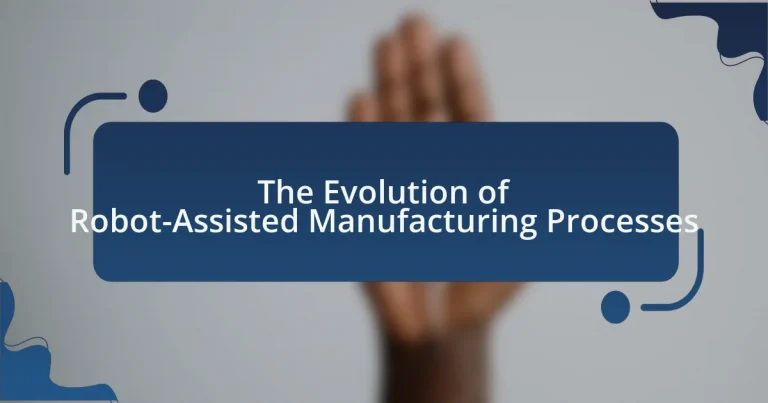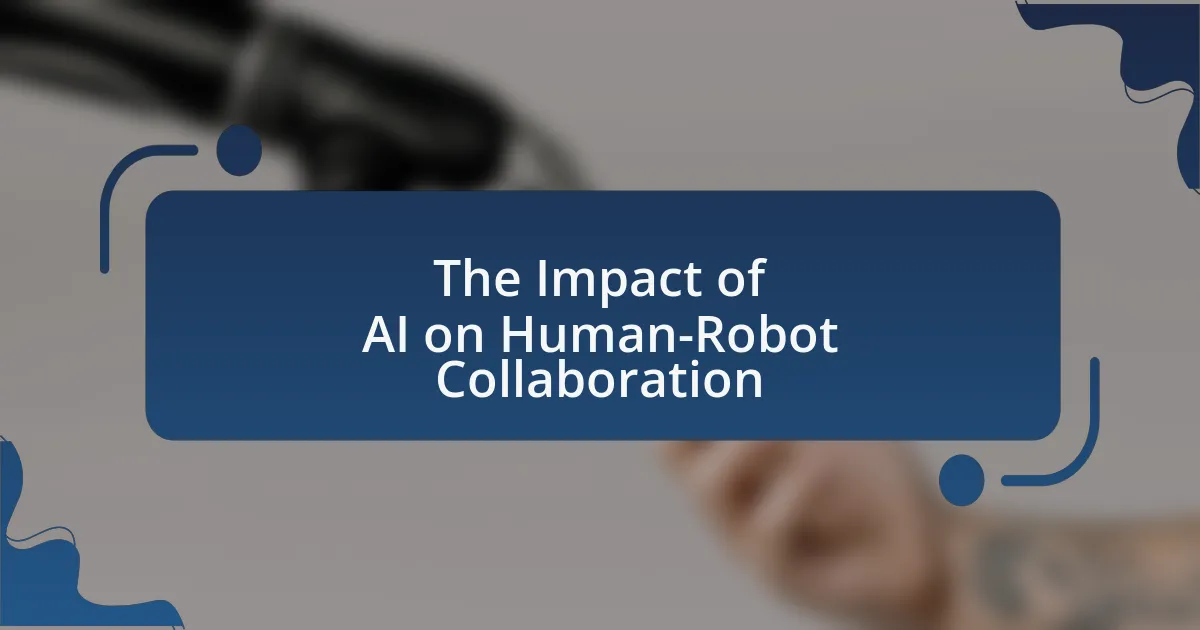The article focuses on the evolution of robot-assisted manufacturing processes, tracing their development from the introduction of the first industrial robots in the 1950s to the current advancements in artificial intelligence and collaborative robotics. Key milestones include the emergence of programmable robots, the integration of computer technology, and the rise of collaborative robots that work alongside human operators. The article discusses the impact of technological advancements on efficiency, productivity, and safety in manufacturing, as well as the challenges and barriers to adoption, such as high costs and workforce displacement. Additionally, it highlights the future trends in automation and the necessary skills for workers to adapt to this evolving landscape.
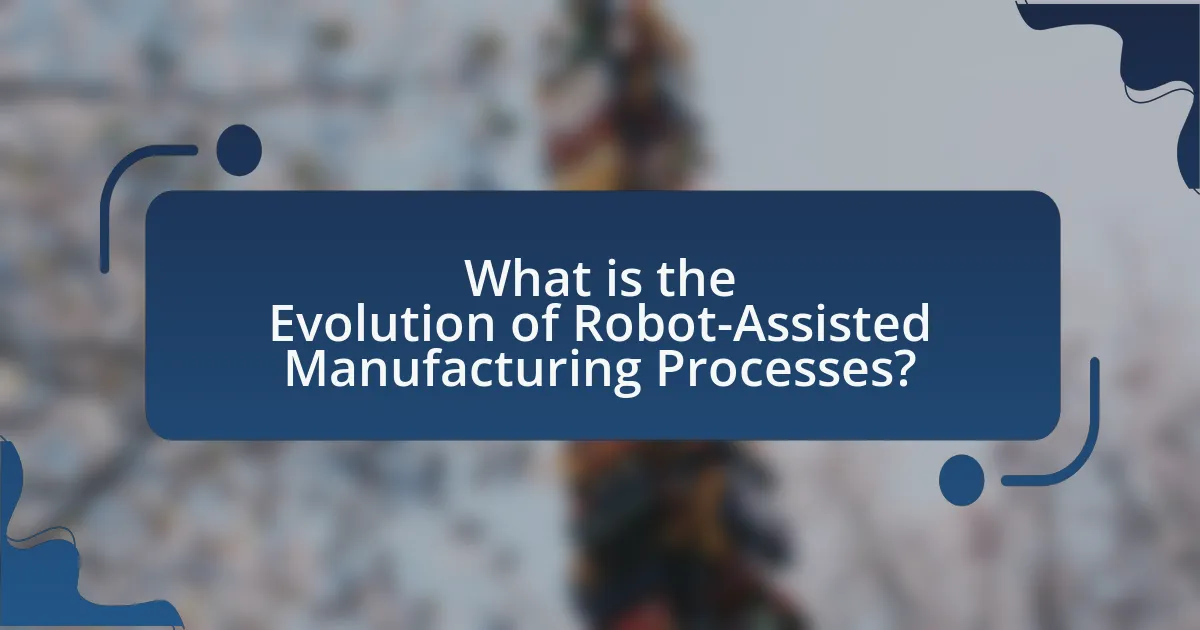
What is the Evolution of Robot-Assisted Manufacturing Processes?
The evolution of robot-assisted manufacturing processes began in the 1950s with the introduction of the first industrial robots, such as Unimate, which was used for tasks like die casting and welding. Over the decades, advancements in technology led to increased automation, with robots becoming more versatile and capable of performing complex tasks. By the 1980s, the integration of computer technology allowed for programmable robots, enhancing precision and efficiency in manufacturing.
In the 2000s, the rise of collaborative robots, or cobots, marked a significant shift, enabling robots to work alongside human operators safely. This evolution has been driven by the need for increased productivity, reduced labor costs, and improved quality control. According to a report by the International Federation of Robotics, global sales of industrial robots reached approximately 384,000 units in 2020, reflecting the growing reliance on automation in manufacturing.
Today, robot-assisted manufacturing processes continue to evolve with advancements in artificial intelligence, machine learning, and the Internet of Things, further enhancing the capabilities and applications of robots in various industries.
How have robot-assisted manufacturing processes developed over time?
Robot-assisted manufacturing processes have evolved significantly since their inception in the mid-20th century. Initially, in the 1960s, industrial robots were primarily used for repetitive tasks such as welding and assembly, with limited flexibility and programming capabilities. Over the decades, advancements in technology have led to the development of more sophisticated robots equipped with artificial intelligence, machine learning, and enhanced sensors, allowing for greater adaptability and precision in manufacturing environments.
By the 1980s and 1990s, the introduction of computer numerical control (CNC) systems and improved robotics software enabled robots to perform complex tasks with higher accuracy and efficiency. The integration of robotics with automation systems further streamlined production processes, reducing labor costs and increasing output.
In the 21st century, the rise of collaborative robots, or cobots, has transformed manufacturing by allowing human workers and robots to work side by side safely. These developments have been supported by significant investments in research and development, with the global industrial robotics market projected to reach $70 billion by 2025, reflecting the growing reliance on robot-assisted processes in various industries.
What were the key milestones in the evolution of these processes?
The key milestones in the evolution of robot-assisted manufacturing processes include the introduction of the first industrial robot, Unimate, in 1961, which revolutionized automation in manufacturing. In 1973, the development of the first programmable logic controllers (PLCs) allowed for more flexible and efficient control of manufacturing processes. The 1980s saw the emergence of computer numerical control (CNC) machines, enhancing precision and repeatability in manufacturing tasks. In the 1990s, advancements in artificial intelligence and machine learning began to integrate with robotics, enabling adaptive and intelligent manufacturing systems. The introduction of collaborative robots, or cobots, in the early 2000s marked a significant shift, allowing robots to work alongside human operators safely. These milestones collectively demonstrate the progressive enhancement of efficiency, flexibility, and safety in manufacturing through robotic technology.
How have technological advancements influenced robot-assisted manufacturing?
Technological advancements have significantly enhanced robot-assisted manufacturing by improving efficiency, precision, and flexibility. For instance, the integration of artificial intelligence and machine learning algorithms allows robots to adapt to varying production demands and optimize their operations in real-time. According to a report by the International Federation of Robotics, the implementation of advanced robotics in manufacturing has led to a 30% increase in productivity and a 20% reduction in operational costs. Additionally, innovations in sensor technology and connectivity, such as the Internet of Things, enable robots to communicate and collaborate seamlessly, further streamlining manufacturing processes. These advancements collectively contribute to a more agile and responsive manufacturing environment.
What are the main types of robot-assisted manufacturing processes?
The main types of robot-assisted manufacturing processes include welding, assembly, painting, material handling, and machining. Welding robots are widely used for their precision and speed in joining materials, while assembly robots facilitate the efficient construction of products by automating repetitive tasks. Painting robots ensure consistent application of coatings, enhancing quality and reducing waste. Material handling robots streamline the movement of goods within manufacturing facilities, improving productivity. Lastly, machining robots perform tasks such as cutting and drilling with high accuracy, contributing to the overall efficiency of manufacturing operations. These processes collectively enhance productivity, reduce labor costs, and improve product quality in modern manufacturing environments.
What distinguishes industrial robots from collaborative robots in manufacturing?
Industrial robots are designed for high-speed, high-precision tasks in manufacturing environments, while collaborative robots, or cobots, are engineered to work alongside human operators safely. Industrial robots typically operate in isolated areas due to their speed and strength, requiring safety barriers, whereas collaborative robots are equipped with sensors and safety features that allow them to interact directly with humans without the need for extensive safety measures. This distinction is crucial as it reflects the evolving role of robots in manufacturing, where the integration of collaborative robots enhances flexibility and efficiency in production processes.
How do different types of robots contribute to various manufacturing tasks?
Different types of robots contribute to various manufacturing tasks by enhancing efficiency, precision, and safety across production lines. Industrial robots, such as articulated robots, are commonly used for tasks like welding, painting, and assembly due to their ability to perform repetitive tasks with high accuracy. Collaborative robots, or cobots, work alongside human operators, assisting in tasks like material handling and quality inspection, which improves workflow and reduces the risk of injury. Mobile robots facilitate logistics by transporting materials within manufacturing facilities, optimizing supply chain operations. According to a report by the International Federation of Robotics, the use of industrial robots increased by 12% in 2020, demonstrating their growing role in manufacturing efficiency.
What are the benefits of implementing robot-assisted manufacturing processes?
Implementing robot-assisted manufacturing processes enhances efficiency, precision, and safety in production environments. Robots can operate continuously without fatigue, leading to increased output and reduced cycle times. For instance, a study by the International Federation of Robotics reported that companies utilizing robotic automation saw productivity increases of up to 30%. Additionally, robots perform tasks with high accuracy, minimizing errors and waste, which is crucial in industries like automotive manufacturing where precision is paramount. Furthermore, robot-assisted processes improve workplace safety by taking over hazardous tasks, thereby reducing the risk of injury for human workers. This combination of benefits contributes to lower operational costs and higher overall productivity in manufacturing settings.
How do these processes enhance productivity and efficiency?
Robot-assisted manufacturing processes enhance productivity and efficiency by automating repetitive tasks, which reduces human error and increases output speed. Automation allows for continuous operation without breaks, leading to higher production rates. For instance, a study by McKinsey & Company found that automation can increase productivity by up to 30% in manufacturing settings. Additionally, robots can perform tasks with precision and consistency, minimizing waste and optimizing resource utilization, which further contributes to overall efficiency.
What impact do they have on product quality and consistency?
Robot-assisted manufacturing processes significantly enhance product quality and consistency by minimizing human error and ensuring precise execution of tasks. These automated systems operate with high accuracy, which leads to uniformity in production outputs. For instance, a study by the Massachusetts Institute of Technology found that implementing robotic systems in manufacturing can reduce defects by up to 50%, demonstrating a direct correlation between automation and improved product quality. Additionally, robots can maintain consistent performance over extended periods, which further stabilizes production processes and results in reliable product consistency.
How do robot-assisted manufacturing processes integrate with Industry 4.0?
Robot-assisted manufacturing processes integrate with Industry 4.0 through the use of advanced technologies such as the Internet of Things (IoT), artificial intelligence (AI), and big data analytics. These technologies enable robots to communicate with each other and with other machines, facilitating real-time data exchange and decision-making. For instance, IoT sensors embedded in robotic systems allow for continuous monitoring of performance and predictive maintenance, which enhances operational efficiency. Additionally, AI algorithms can analyze data collected from manufacturing processes to optimize workflows and improve product quality. This integration is evidenced by the increasing adoption of smart factories, where interconnected robotic systems operate autonomously, leading to increased productivity and reduced downtime.
What role do data analytics and IoT play in these processes?
Data analytics and IoT are crucial in enhancing the efficiency and effectiveness of robot-assisted manufacturing processes. Data analytics enables the collection and analysis of vast amounts of operational data, allowing manufacturers to identify patterns, optimize workflows, and predict maintenance needs. For instance, a study by McKinsey & Company found that data-driven decision-making can improve productivity by up to 20%. IoT devices facilitate real-time monitoring and communication between machines, leading to improved coordination and reduced downtime. According to a report by Gartner, IoT adoption in manufacturing can lead to a 30% reduction in operational costs. Together, data analytics and IoT drive innovation and operational excellence in robot-assisted manufacturing.
How does automation influence workforce dynamics in manufacturing?
Automation significantly alters workforce dynamics in manufacturing by enhancing productivity and shifting job roles. As machines take over repetitive tasks, human workers increasingly focus on complex problem-solving and oversight roles. For instance, a study by McKinsey & Company indicates that automation could displace up to 30% of jobs by 2030, while simultaneously creating new opportunities in technology management and maintenance. This transition necessitates reskilling and upskilling of the workforce to adapt to new technologies, ultimately leading to a more skilled labor pool.
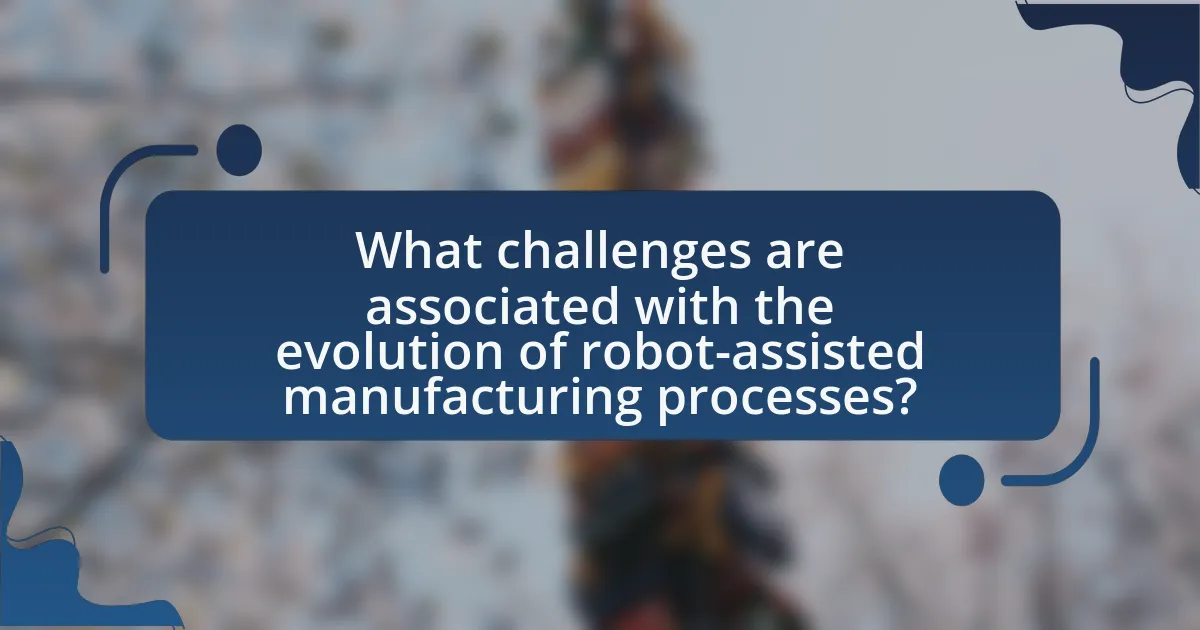
What challenges are associated with the evolution of robot-assisted manufacturing processes?
The challenges associated with the evolution of robot-assisted manufacturing processes include high initial costs, integration complexities, and workforce displacement. High initial costs arise from the investment required for advanced robotics and automation technologies, which can deter smaller manufacturers from adopting these systems. Integration complexities stem from the need to seamlessly incorporate robots into existing production lines, often requiring significant modifications to workflows and infrastructure. Workforce displacement is a critical concern, as automation can lead to job losses in traditional manufacturing roles, necessitating retraining and upskilling of employees to adapt to new technologies. These challenges highlight the need for strategic planning and investment in human capital to ensure successful implementation of robot-assisted manufacturing.
What are the common barriers to adopting robot-assisted manufacturing?
Common barriers to adopting robot-assisted manufacturing include high initial costs, lack of skilled workforce, integration challenges with existing systems, and concerns about return on investment. High initial costs can deter companies from investing in robotic systems, as they often require significant capital for purchase and installation. The lack of a skilled workforce is critical, as many organizations struggle to find employees who can operate and maintain advanced robotic systems. Integration challenges arise when companies attempt to incorporate robots into their existing manufacturing processes, which can lead to disruptions and inefficiencies. Lastly, concerns about return on investment stem from uncertainty regarding the long-term benefits of automation, making businesses hesitant to commit to such technologies.
How do costs and investment affect the implementation of these processes?
Costs and investment significantly influence the implementation of robot-assisted manufacturing processes by determining the feasibility and scale of adoption. High initial costs for robotic systems, including purchase, installation, and maintenance, can deter companies from integrating these technologies. For instance, a study by the International Federation of Robotics indicates that the average cost of industrial robots can range from $25,000 to $400,000, depending on the complexity and capabilities required. Additionally, substantial investment in training and workforce development is necessary to ensure that employees can effectively operate and maintain these systems. Companies that allocate sufficient resources towards these investments often experience improved efficiency and productivity, as evidenced by a report from McKinsey, which found that automation can increase productivity by up to 30% in manufacturing sectors. Thus, the interplay of costs and investment directly shapes the extent to which organizations can successfully implement and benefit from robot-assisted manufacturing processes.
What skills are required for workers to effectively operate and maintain robots?
Workers need technical skills, problem-solving abilities, and knowledge of robotics systems to effectively operate and maintain robots. Technical skills include proficiency in programming languages such as Python or C++, as well as familiarity with robotic operating systems and software. Problem-solving abilities are essential for troubleshooting issues that arise during operation, ensuring minimal downtime. Knowledge of robotics systems encompasses understanding mechanical, electrical, and software components, which is critical for maintenance tasks. According to a report by the World Economic Forum, 85 million jobs may be displaced by automation by 2025, highlighting the increasing demand for skilled workers in robotics.
How do safety regulations impact robot-assisted manufacturing processes?
Safety regulations significantly enhance the safety and efficiency of robot-assisted manufacturing processes by establishing standards that protect workers and ensure operational reliability. These regulations require manufacturers to implement safety measures such as risk assessments, safety training, and the use of protective equipment, which collectively reduce the likelihood of accidents and injuries. For instance, the Occupational Safety and Health Administration (OSHA) mandates that employers adhere to specific safety protocols when integrating robots into their workflows, leading to a documented decrease in workplace incidents. Compliance with these regulations not only safeguards employees but also promotes a culture of safety that can improve productivity and operational performance in manufacturing environments.
What are the key safety standards that must be adhered to?
The key safety standards that must be adhered to in robot-assisted manufacturing processes include ISO 10218, which outlines safety requirements for industrial robots, and ISO/TS 15066, which provides guidelines for collaborative robots. These standards ensure that robots operate safely alongside human workers by addressing risks such as collision and injury. Compliance with these standards is critical, as they are recognized internationally and help mitigate hazards in manufacturing environments, thereby protecting both personnel and equipment.
How can manufacturers ensure a safe working environment with robots?
Manufacturers can ensure a safe working environment with robots by implementing comprehensive safety protocols and integrating advanced safety technologies. These protocols include conducting risk assessments to identify potential hazards associated with robot operations, establishing safety zones, and utilizing safety-rated hardware such as light curtains and emergency stop buttons. Additionally, manufacturers should provide thorough training for employees on safe interaction with robots and regularly update safety measures based on evolving technologies and operational practices. According to the International Federation of Robotics, the adoption of safety standards like ISO 10218 and ISO/TS 15066 has been crucial in minimizing workplace accidents involving robots, demonstrating that adherence to established safety guidelines significantly enhances worker safety in automated environments.
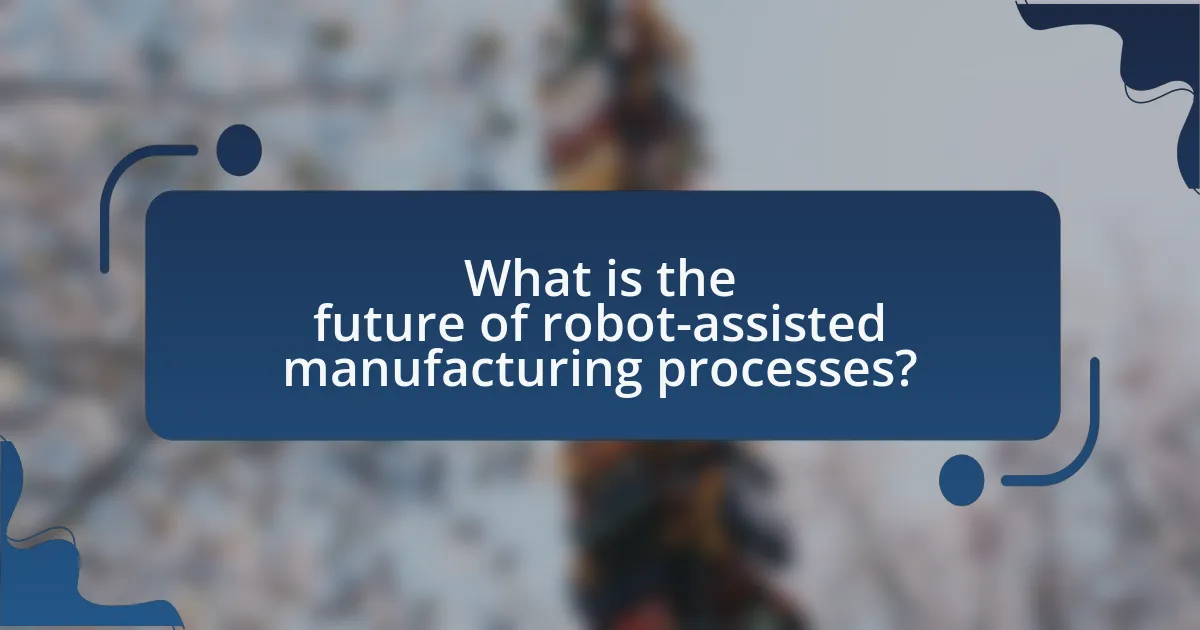
What is the future of robot-assisted manufacturing processes?
The future of robot-assisted manufacturing processes is characterized by increased automation, enhanced collaboration between humans and robots, and the integration of advanced technologies such as artificial intelligence and machine learning. These advancements will lead to greater efficiency, flexibility, and precision in manufacturing operations. For instance, a report by McKinsey & Company indicates that automation could increase productivity by up to 30% in various sectors by 2030. Additionally, the use of collaborative robots (cobots) is expected to rise, allowing for safer and more effective human-robot interactions on the factory floor. This evolution will not only streamline production but also enable manufacturers to respond more swiftly to market demands and customize products at scale.
How are emerging technologies shaping the future of these processes?
Emerging technologies are significantly shaping the future of robot-assisted manufacturing processes by enhancing automation, improving efficiency, and enabling real-time data analytics. For instance, advancements in artificial intelligence and machine learning allow robots to learn from their environments and optimize their operations, leading to reduced downtime and increased productivity. According to a report by McKinsey, automation could increase global productivity by 0.8 to 1.4 percent annually, demonstrating the potential impact of these technologies on manufacturing efficiency. Additionally, the integration of the Internet of Things (IoT) facilitates seamless communication between machines, enabling predictive maintenance and minimizing operational disruptions. This interconnectedness is crucial for achieving smart manufacturing, where processes are continuously monitored and adjusted for optimal performance.
What advancements in AI and machine learning are expected to influence robot-assisted manufacturing?
Advancements in AI and machine learning that are expected to influence robot-assisted manufacturing include enhanced predictive analytics, improved computer vision, and advanced reinforcement learning algorithms. Enhanced predictive analytics allows robots to anticipate maintenance needs and optimize production schedules, thereby reducing downtime and increasing efficiency. Improved computer vision enables robots to better identify and manipulate objects in dynamic environments, facilitating more complex assembly tasks. Advanced reinforcement learning algorithms empower robots to learn from their experiences, adapting to new tasks and environments without extensive reprogramming. These advancements are supported by industry reports indicating that AI-driven automation can increase productivity by up to 30% in manufacturing settings.
How might the role of human workers evolve alongside robotic systems?
The role of human workers is likely to evolve towards more supervisory, creative, and complex problem-solving tasks as robotic systems take over repetitive and manual labor. As automation increases, workers will need to adapt by developing skills in areas such as programming, maintenance of robotic systems, and data analysis. For instance, a study by McKinsey Global Institute indicates that by 2030, up to 375 million workers may need to change occupational categories due to automation, highlighting the necessity for reskilling and upskilling in the workforce. This shift will enable human workers to focus on tasks that require emotional intelligence, critical thinking, and interpersonal skills, which are areas where robots currently lack proficiency.
What best practices should manufacturers follow when implementing robot-assisted processes?
Manufacturers should follow several best practices when implementing robot-assisted processes to ensure efficiency and effectiveness. First, conducting a thorough assessment of the production environment is crucial; this includes evaluating existing workflows, identifying tasks suitable for automation, and understanding the specific needs of the operation. Research indicates that companies that perform detailed assessments can achieve up to a 30% increase in productivity post-implementation.
Next, selecting the right type of robot for the specific tasks is essential. Different robots, such as collaborative robots (cobots) or industrial robots, serve varied functions and capabilities. A study by the International Federation of Robotics shows that 70% of successful implementations are linked to the appropriate robot selection based on task requirements.
Additionally, training employees to work alongside robots is vital. Providing comprehensive training programs enhances human-robot collaboration and reduces resistance to new technologies. According to a report by McKinsey, organizations that invest in employee training during automation transitions see a 20% improvement in overall operational performance.
Lastly, continuous monitoring and optimization of robot-assisted processes are necessary. Implementing feedback loops and performance metrics allows manufacturers to adapt and refine processes over time. Data from the Automation World indicates that companies that regularly analyze performance data can improve efficiency by 15% annually.
By following these best practices—conducting assessments, selecting appropriate robots, training employees, and monitoring processes—manufacturers can successfully implement robot-assisted processes and enhance their operational capabilities.
How can companies effectively train their workforce for robot integration?
Companies can effectively train their workforce for robot integration by implementing a structured training program that includes hands-on experience, simulation-based learning, and continuous education. A structured program allows employees to engage directly with robotic systems, fostering familiarity and confidence. Simulation-based learning provides a risk-free environment for employees to practice and understand robotic operations without the potential for costly errors. Continuous education ensures that workers stay updated on technological advancements and best practices, which is crucial as robotics technology evolves rapidly. According to a study by the International Federation of Robotics, companies that invest in comprehensive training programs see a 20% increase in productivity and a 30% reduction in operational errors, demonstrating the effectiveness of such training initiatives.
What strategies can be employed to maximize the return on investment in robot-assisted manufacturing?
To maximize the return on investment in robot-assisted manufacturing, companies should implement strategies such as optimizing workflow integration, investing in employee training, and utilizing data analytics for continuous improvement. Optimizing workflow integration ensures that robots work seamlessly with existing processes, reducing downtime and increasing productivity. For instance, a study by McKinsey & Company found that companies that effectively integrate automation into their workflows can see productivity gains of up to 30%.
Investing in employee training enhances the skills of the workforce, enabling them to work alongside robots efficiently and troubleshoot issues as they arise. According to the World Economic Forum, companies that prioritize training in automation technologies can achieve a 20% increase in operational efficiency.
Utilizing data analytics allows manufacturers to monitor performance metrics and identify areas for improvement, leading to better decision-making and resource allocation. Research from Deloitte indicates that organizations leveraging data analytics in manufacturing can improve their return on investment by 15% to 20%.
These strategies collectively enhance productivity, efficiency, and adaptability, thereby maximizing the return on investment in robot-assisted manufacturing.
